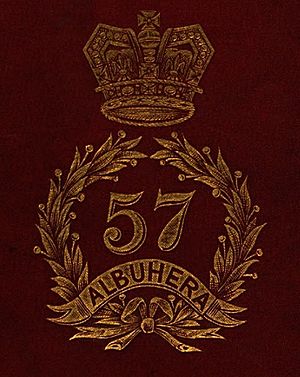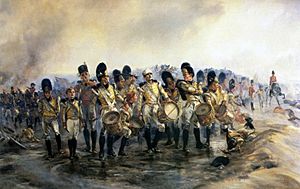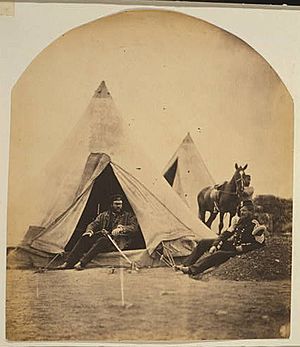57th (West Middlesex) Regiment of Foot facts for kids
Quick facts for kids 57th (West Middlesex) Regiment of Foot |
|
|---|---|

Badge of the 57th (West Middlesex) Regiment of Foot
|
|
| Active | 1755 to 1881 |
| Country | |
| Branch | |
| Type | Line Infantry |
| Role | Light Infantry |
| Size | One battalion (two battalions 1803–1815) |
| Garrison/HQ | Hounslow Barracks |
| Nickname(s) | "The Steelbacks" "The Die Hards" |
| Motto(s) | Honi soit qui mal y pense (Evil be to Him, who Evil Thinks) |
| Colors | Yellow facings, gold braided lace |
| March | Quick: Sir Manley Power Slow: Caledonian |
| Engagements | American Revolutionary War French Revolutionary Wars Napoleonic Wars Crimean War Indian Rebellion New Zealand Wars Anglo-Zulu War |
The 57th (West Middlesex) Regiment of Foot was a famous regiment of soldiers in the British Army. They were known for being very brave and tough. This group of soldiers was first formed in 1755. Over time, they fought in many important wars around the world. In 1881, the 57th Regiment joined with another regiment, the 77th (East Middlesex) Regiment of Foot, to create a new group called the Middlesex Regiment.
Contents
History of the 57th Regiment
The 57th Regiment had a long and exciting history. They served in many different parts of the world. From their early days to their most famous battles, these soldiers were always ready for action.
Early Battles and Adventures

The regiment started in 1755 in England, in areas called Somerset and Gloucester. It was first known as the 59th Regiment of Foot. They were formed to fight in the Seven Years' War. In 1756, they changed their name to the 57th Regiment of Foot.
At first, these soldiers worked like marines, serving on ships. They were sent to Gibraltar in 1757, then to Menorca in 1763, and Ireland in 1767.
In 1776, the regiment sailed to America to fight in the American Revolutionary War. They were part of the Battle of Long Island in August 1776. They also bravely stormed Fort Montgomery in October 1777. Later, some of their soldiers were captured at the Siege of Yorktown in October 1781.
In 1782, the regiment added "the West Middlesex" to its name. This showed where many of its soldiers came from. After the war, they moved to Nova Scotia in 1783 and returned to England in 1790.
The "Die Hards" in the Napoleonic Wars


In 1793, the regiment went to Europe to fight in the Flanders Campaign. They helped protect a town called Nieuwpoort. They returned home but went back to Flanders in 1794.
Later, in 1796, they sailed to the West Indies. They helped capture Saint Lucia and then went to Trinidad. They returned to England in 1803. During this time, a second group (battalion) was formed for the regiment.
In 1809, the 1st battalion went to Portugal to fight in the Peninsular War. This was a big war against Napoleon's French army.
The regiment earned its famous nickname, "the Die Hards," during the Battle of Albuera in May 1811. This was one of the bloodiest battles of the war. The regiment's leader, Colonel William Inglis, was badly hurt. But he refused to leave his men. He lay on the ground and shouted, "Die hard the 57th, die hard!"
The soldiers fought with incredible bravery. Out of 570 men, 422 were killed or wounded. The general in charge said that the 57th Regiment's dead soldiers were "lying as they fought in the ranks." This showed how bravely they stood their ground.
The battalion also fought in the Battle of Vitoria in 1813. They chased the French army into France. They fought in the Battle of the Pyrenees, the Battle of Nivelle, and the Battle of the Nive. In 1814, they went to North America for the War of 1812, but they didn't see any fighting there.
Victorian Era Service Around the World

In 1824, the regiment traveled to New South Wales (Australia) as guards for prisoners. They then moved to India in 1830. While in India, they helped stop a rebellion in 1837.
In 1854, the regiment went to fight in the Crimean War. They fought bravely at the Battle of Inkerman and during the long Siege of Sevastopol.
After the Crimean War, they went to Malta. In 1858, they sailed back to India to help stop the Indian Rebellion.
In 1860, the regiment moved to New Zealand to fight in the New Zealand Wars. Two soldiers, Ensign John Thornton Down and Drummer Dudley Stagpoole, won the Victoria Cross for their amazing bravery in 1863. The Victoria Cross is the highest award for bravery in the British military.
The regiment returned to England in 1867. They later served in Ceylon and then in South Africa in 1879 for the Anglo-Zulu War.
Finally, in 1881, the 57th Regiment joined with the 77th Regiment to form the new Middlesex Regiment. This marked the end of the 57th as a separate unit.
Victoria Cross Heroes
Four brave soldiers from the 57th Regiment earned the Victoria Cross, the highest award for courage:
- Ensign John Thornton Down (New Zealand Wars, 1863)
- Sergeant George Gardiner (Crimean War, 1855)
- Private Charles McCorrie (Crimean War, 1855)
- Drummer Dudley Stagpoole (New Zealand Wars, 1863)
Battle Honours
The regiment was awarded special honors for its bravery in many battles. These honors were often displayed on their flags:
- Peninsular War: Albuhera, Vittoria, Pyrenees, Nivelle, Nive, Peninsula
- Crimean War: Inkerman, Sevastapol
- Later wars: New Zealand, South Africa (1879)
|
See also
- Edwin Bezar – The last known surviving member of the 57th Regiment.

